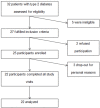Impact of Diabetes-Specific Nutritional Formulas versus Oatmeal on Postprandial Glucose, Insulin, GLP-1 and Postprandial Lipidemia
- PMID: 27455318
- PMCID: PMC4963919
- DOI: 10.3390/nu8070443
Impact of Diabetes-Specific Nutritional Formulas versus Oatmeal on Postprandial Glucose, Insulin, GLP-1 and Postprandial Lipidemia
Abstract
Diabetes-specific nutritional formulas (DSNFs) are frequently used as part of medical nutrition therapy for patients with diabetes. This study aims to evaluate postprandial (PP) effects of 2 DSNFs; Glucerna (GL) and Ultra Glucose Control (UGC) versus oatmeal (OM) on glucose, insulin, glucagon-like peptide-1 (GLP-1), free fatty acids (FFA) and triglycerides (TG). After an overnight fast, 22 overweight/obese patients with type 2 diabetes were given 200 kcal of each of the three meals on three separate days in random order. Blood samples were collected at baseline and at 30, 60, 90, 120, 180 and 240 min. Glucose area under the curve (AUC0-240) after GL and UGC was lower than OM (p < 0.001 for both). Insulin positive AUC0-120 after UGC was higher than after OM (p = 0.02). GLP-1 AUC0-120 and AUC0-240 after GL and UGC was higher than after OM (p < 0.001 for both). FFA and TG levels were not different between meals. Intake of DSNFs improves PP glucose for 4 h in comparison to oatmeal of similar caloric level. This is achieved by either direct stimulation of insulin secretion or indirectly by stimulating GLP-1 secretion. The difference between their effects is probably related to their unique blends of amino acids, carbohydrates and fat.
Keywords: clinical nutrition; diabetes; meal replacement; medical food; nutritional formula; obesity.
Figures





References
-
- Nathan D.M., Buse J.B., Davidson M.B., Ferrannini E., Holman R.R., Sherwin R., Zinman B. American Diabetes A, European Association for the Study of D: Medical management of hyperglycaemia in type 2 diabetes mellitus: A consensus algorithm for the initiation and adjustment of therapy: A consensus statement from the American Diabetes Association and the European Association for the Study of Diabetes. Diabetologia. 2009;52:17–30. - PubMed
-
- Morris S.F., Wylie-Rosett J. Medical nutrition therapy: A key to diabetes management and prevention. Clin. Diabetes. 2010;28:12. doi: 10.2337/diaclin.28.1.12. - DOI
Publication types
MeSH terms
Substances
Grants and funding
LinkOut - more resources
Full Text Sources
Other Literature Sources
Medical
Miscellaneous

